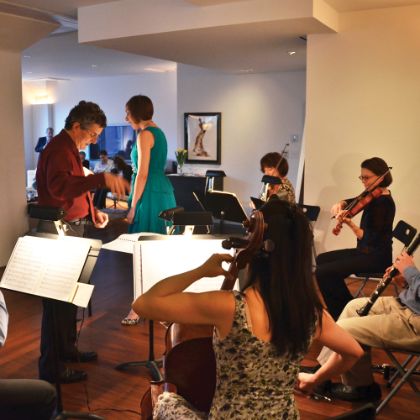Concert halls try to cater to the Twenty-First Century.
By Brian Wise
Barely halfway into its first season in 1962, the late conductor George Szell pronounced Lincoln Center’s Philharmonic Hall a disaster. “Tear the place down and start over again!” he famously declared. That was unthinkable. But Szell wasn’t alone, and the theater — now called David Geffen Hall — has undergone two major renovations and several incremental tweaks since, leading one prominent acoustics expert to call it the “East Coast graveyard for acousticians.” Another makeover is expected to begin in 2019, more radical than the last ones and at an estimated budget of $500 million.
As with many other concert hall renovations, the refurbishment of David Geffen Hall, home to the New York Philharmonic, comes at a time of difficult orchestra economics and shifting audience habits. Gilded halls of the Victorian age and utopian arts campuses of the Sixties alike are being revamped to not only add restrooms and wider seats with more legroom, but also multimedia capabilities, flexible acoustics and public lobbies.
“The purists and traditionalists are losing ground to people who are willing to embrace new ways of connecting with audiences,” said Joshua Dachs, a principal at Fisher Dachs Associates, a theatrical consulting firm that will also be involved with the David Geffen Hall renovation. “The interesting question is, what does that mean at scale?”
Dachs asks whether it’s possible to capture the visceral qualities that a listener experiences in a jazz bar or a rock club, only on a larger scale. He cites the acclaimed, Frank Gehry-designed New World Center in Miami Beach, Florida, which opened in 2011 with only seven hundred sixty-five seats — well below the two thousand seven hundred thirty-eight now in David Geffen Hall. “That alone creates a more engaging experience because you’re that much closer to the people making music,” said Dachs. “An orchestra only makes so much sound and when you’re in a small room it feels louder and more powerful.”
In the case of David Geffen Hall, everyone has an opinion. Architectural historian Victoria Newhouse believes that Lincoln Center planners should go even further than the New World Center in emphasizing intimacy. “I am distressed by what’s going on at Geffen Hall, which I think is totally misguided,” said Newhouse, author of Site and Sound: The Architecture and Acoustics of New Opera Houses and Concert Halls. “The last thing this city needs is another large concert hall.”
Newhouse contends that the future lies in small, flexible spaces like National Sawdust, in Williamsburg, Brooklyn, and Le Poisson Rouge, in Greenwich Village, where she sees adventurous young audiences sipping cocktails as they listen. “What they need, if they do anything at Lincoln Center, is three, maybe four, small pavilions where you can have three or four hundred people in the audience and achieve a sense of intimacy and personal connection with the music. The people on these boards at these old, established institutions have got to get a handle on what’s going on in the world today.”
A Lincoln Center spokesman said in a statement that the organization plans to build on the existing footprint of David Geffen Hall while adding new amenities; plans are to be unveiled this summer. But any reduction in seats would need to be offset through higher ticket prices or donor subsidies. Nevertheless, numerous concert presenters have sought to correct what they recognize as the overbuilding of earlier eras. Orchestra Hall in Minneapolis, built in 1974, shed three hundred sixty-five seats in a makeover that ended in 2013. The Dorothy Chandler Pavilion in Los Angeles, built in 1964, is expected to shrink by two hundred seats when it undergoes an upcoming facelift; Cincinnati’s 1878 Music Hall is expected to lose nearly one thousand of its three thousand four hundred seventeen seats when renovations begin this summer (upsetting some donors and preservationists who call the plan excessive).
Many orchestras feel a sense of urgency in their renovation projects; some have folded and others are seeing their audiences shift from season-long subscriptions to single ticket sales. Kyu-Young Kim, the artistic director and principal violin of the St. Paul Chamber Orchestra, says that the orchestra’s new hall at the Ordway Center for the Performing Arts has been designed in part to meet the needs of the pop, rock and dance groups with which it will share the space. “There was a little bit of pushback from people who have been [attending concerts] for a long time but it’s mostly been very welcomed,” said Kim, who added that drinks are now permitted in the auditorium.
Along with a sleeker design, the Ordway features seating in loft-like tiers around the orchestra stage, based on the so-called vineyard model pioneered by the Berlin Philharmonie in 1962. Lincoln Center experimented with this approach at the Mostly Mozart Festival in 2005 and 2006, when the orchestra was moved thirty feet out into Avery Fisher Hall on a temporary stage platform. Audience members were seated on stage risers and along the sides of the new platform — “so close you can read the music over the violinist’s shoulder,” said Dachs, whose firm designed the plan.
‘How do we do more with the infrastructure that we’re building for the performing arts?’
“Purists will say the sound is not properly balanced. My answer to that is ‘Okay, you can go home and listen to a CD and it will be properly balanced.’ But I won’t be able to see who’s playing and I won’t be as engaged as I am right now.” (Whether a vineyard or a shoebox configuration — as in the celebrated halls of Amsterdam, Boston and Vienna — yields better results is a subject of a broader debate.)
Sedgwick Clark, the editor of Musical America and a longtime Lincoln Center patron, praised the Mostly Mozart experiment but worries that any renovation of David Geffen Hall will end up favoring pop, rock or Broadway acts over orchestral music. “If they attempt something like that they’ll have a lot to answer for,” said Clark. “They should be able to amplify things. But it worries the hell out of me that it will become a multipurpose facility.”
But amplification no longer needs to come at the expense of acoustic performances. After some high-profile flops, acousticians today benefit from sophisticated computer modeling that enables them to see how a change in seating patterns can impact the sound. There are adjustable canopies over stages and remote-control acoustical curtains. Some have incorporated the acoustical properties of exposed organ pipes into their plans.
But in a visually oriented culture, the single retractable projection screen can seem dated. A future might be found in whole projection walls and movable sail-like ceiling panels that serve as screens for projecting images, an idea that Gehry pioneered at the New World Center in Miami Beach. The hall design — with fourteen thirty-thousand-lumen projectors — has enabled the New World Symphony to commission immersive works by video artists like Tal Rosner and Netia Jones that are closely integrated with music.
Audiences and critics debate whether screens or lighting effects can enhance or detract from a performance, but at best, they can be liberating to a musician. “I think that is absolutely essential for a twenty-first-century hall,” said cellist Johannes Moser. He points to composer Michel van der Aa’s Up-close, a concerto for cello, string orchestra and film that won the Grawemeyer Award in 2013. Moser is less enthusiastic about surround-style seating plans. “The hall sounds great but it is so hard for me as a solo performer to know where I should send my energy, where I should send my sound,” he said. “That is something to really be considered.”
At the new three-hundred-fifty-seat Bing Concert Hall at Stanford University, a platform stage and the first row of seats are at the same elevation — literally ensuring that musicians are not on a pedestal. But for some hall designers, luring new audiences starts outside the auditorium, in the lobby itself.
On a recent winter afternoon, Jonathan Jones, the director of capital projects at the Brooklyn Academy of Music, eyes the narrow entryway of the BAM Harvey Theater, built in 1904. In the minutes before showtime, ticket-holders routinely engage in a cramped ritual, elbowing their way past lines for three narrow box-office windows and past kiosks where V.I.P.’s and critics retrieve their tickets. But soon, says Jones, an interior stairway will be blown out, the lobby widened and connected to three adjacent storefronts that will house an art gallery and a restaurant or cafe. The unified space will be part of a project labeled BAM Strong, which has already brought upgraded seating (with new foot-rests and cup holders) in the eight-hundred-fifty-four-seat auditorium.
BAM is one of many arts venues seeking to refashion aging lobbies as off-hours gathering spaces, in the hope that it will lure people in to use free Wi-Fi connections, purchase food, drinks and, of course, tickets. Starting in the Nineties, venues including Severance Hall in Cleveland, Orchestra Hall in Chicago and the Academy of Music in Philadelphia began to add restaurants to their lobbies. When Alice Tully Hall at Lincoln Center underwent a
$120 million renovation in 2009, the lobby was expanded by six thousand square feet to include a centerpiece restaurant that’s open for lunch and dinner.
“It’s tied to the question of how we do more with that great infrastructure that we’re building for the performing arts,” said Gary McCluskie, a principal at Diamond Schmitt Architects, a Toronto firm that is also working on the David Geffen Hall renovation. He cites the 2008 refurbishment of Royal Festival Hall in London’s Southbank Centre as the gold standard in inclusive design, with bars and restaurants over several tiers, free Wi-Fi, and views over the River Thames. “It’s one of the great examples of changing infrastructure slightly to allow the lobby spaces to be open all day long,” he said, adding that when he visited there were business meetings and even an informal language class being held in the atrium.
The Southbank Centre is home to several ensembles including the London Philharmonic and the Philharmonia Orchestra but the city’s most prominent ensemble, the London Symphony Orchestra, is conducting a feasibility study for a new hall — called the Centre of Music — to replace its current one at the Barbican Centre. The orchestra’s new chief conductor Simon Rattle pushed for it as part of his discussions about returning to London in 2017. The acoustic imperfections of the Barbican Centre seem to be widely agreed upon but some classical musicians have expressed concern about the proposed costs ($395 million) and location (a well-served area near the current Barbican), and argue that money could be better spent on music education initiatives.
As European concert halls have come to grips with diminished state funding amid a tough economic climate, U.S. arts venues have had a different quandary: philanthropists and foundations generously support hall construction, but not their operation. In 2013, the Nashville Symphony narrowly averted a foreclosure on its concert hall, the $123.5 million Schermerhorn Symphony Center, only after a major donor stepped in. The Carnival Center in Miami had a $2.5 million deficit fewer than two years after its opening. According to a University of Chicago study called “Building Better Arts Facilities: Lessons from a U.S. National Study,” this trend was the result of smaller than projected audience sizes and significant budget miscalculations.
Ultimately, the philanthropist Adrienne Arsht bailed out the Miami facility with a $30 million donation to which naming rights were attached. “The Arsht Center for the Performing Arts is one of many examples of cultural building projects that started out with a grand vision and correspondingly ambitious goals, but then encountered serious hurdles trying to achieve those goals,” wrote the University of Chicago study’s authors.
During a cultural building boom that took place between 1994 and 2008, cities throughout the US invested close to $16 billion in construction and renovation of cultural facilities. While civic leaders and politicians have long placed their hopes on cultural building to spur economic development in downtown areas, post-recession concert halls increasingly aim to be both iconic and egalitarian, aspirational and down-to-earth.
“Architecture has become such a star-driven, media-hungry profession — whereas in the past it was a service profession that was doing good solid work — that in order to get ahead you have to stand out from the crowd,” said Dachs, the theater consultant. “It’s not about doing something traditional really, really well. It’s now all about doing something that nobody’s ever seen before. Pursuit of that sometimes leads to less than optimal results.”

-

From Christemasse to Carole
The birth of Christmas in medieval England
Read More
By David Vernier -

The Next (Not-So-)Big Thing
New chamber orchestras are popping up all over America.
Read More
By Colin Eatock -

A Father's Lament
Finding solace in the sound of authentic sorrow
Read More
By Rev. Jake Bohstedt Morrill